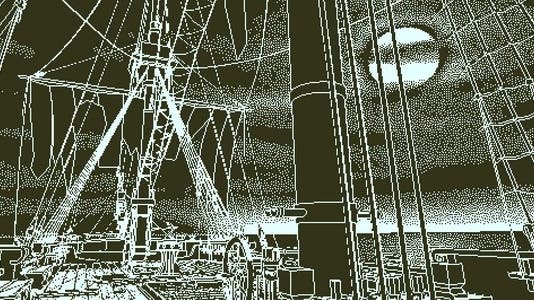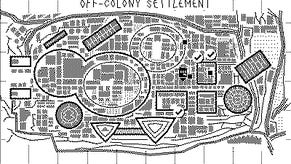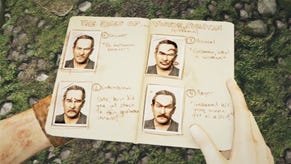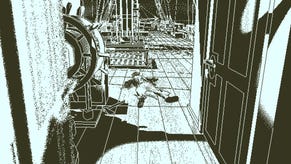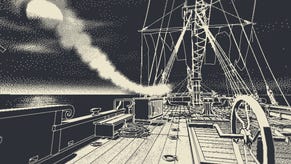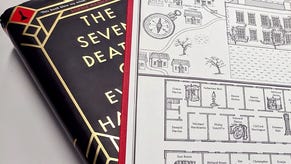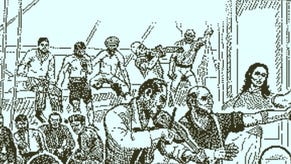Return of the Obra Dinn review - prepare to be transported
Stirring stuff.
"You can't stir things apart," says Thomasina, the brilliant teenage mathematician and physicist in Tom Stoppard's Arcadia. Thomasina is talking, I think, about entropy, and entropy is one of those fascinating, dizzying subjects that can make a person wish they had kicked off their Obra Dinn review with a close reading of a Bryan Ferry lyric instead. No matter, Thomasina is talking about the way that the present generally looks like the past after it's been through a blender. She is talking about the force that means we can remember yesterday and not tomorrow. (For more on all of this you could do a lot worse than tracking down James Gleick's wonderful book Time Travel: A History.) Sad stuff, I reckon, because there are so many things you might want to stir apart. Over the course of this morning alone I can think of two or three at least. You can't stir things apart: amazing, amazing line - so rich and funny and direct and unpatronising and profound. I often walk around my house when nobody is there speaking it aloud to myself and the cats. I will probably crochet it on something one of these days.
Anyway, in Return of the Obra Dinn, guess what? You can stir things apart, albeit only temporarily and with very limited agency. This transgression requires magic, which this wonderfully tactile and rigorous game is very happy to accomodate, and this magic is deployed in the name of a great bureaucratic truth. Lucas Pope, who once wrung such drama from the stamps and passports of a border crossing kiosk in Papers, Please, has now delivered a great "insurance adventure", a romance of book-keeping on the high seas, four years in the making. Speaking of four years, in 1803, the Obra Dinn, a merchant ship of 800 tons, 18 ft draught, was lost at sea with all 51 souls (or were there more?). In 1807 it is back, devoid of life, and ready for an audit and an inquest. It's your job to board the creaking ghost ship, starkly, ghoulishly bereft in powdery white lines picked out against a muddy sepia background, and uncover what happened and how much insurance is to be paid out. But with nobody left alive, how do you proceed? Magic. Magic of a most practical kind.
Your first tool is a magical pocketwatch that allows you to interrogate any sun-bleached skeleton you find on deck by revisiting the moment of its owner's death. Actually, you are transported to a moment a few seconds before their death: you hold out the pocketwatch, the hands spin madly (the arrow of time is having a funny spell), the music riffs bracingly, and then the Obra Dinn briskly stirs things apart. What follows is a very short audio drama - always far less than a minute - with the text appearing on the otherwise blank screen to the accompaniment of the spoken dialogue and the creaks and shudders of the good ship. Then, you are suddenly able to explore the very instant of death, frozen in place via a diorama that you can walk around and poke about in.
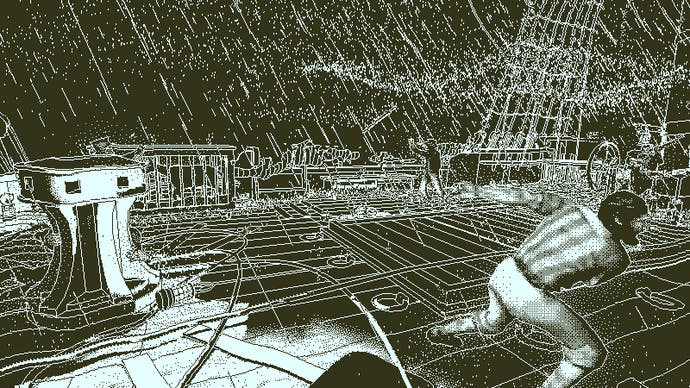
What instants! A blast of lightning up in the rigging, the boom and backscatter of a runaway cannon. Nothing in Obra Dinn deserves to be spoiled, but the game is astonishingly good at capturing the strange otherworldliness of human chaos, that rupturing sense of affront at the sheer unlikeliness of what has come to pass. Heads are cleaved, skin is shredded, bones are splintered, and the bystanders! You never saw such bystanding - arrested while running away from calamity, running towards calamity, turning in surprise, or still, touchlingly, sweetly oblivious for a few nanoseconds more.
Next comes the second tool at your disposal, a magical book that breaks the Obra Dinn's damned voyage down into chapters. At the start of the game the chapter headings are all present but the pages are blank. They fill themselves in with each death you uncover - and frequently one death will lead to more, since the pocketwatch can move from a skeleton that's physically survived intact on the Obra Dinn to reveal, one at a time, the ghosts of other bodies, and other moments of death, that preceded them. This book! It doesn't just list the locations of bodies and record the dialogue from the audio clips, it also poses questions, always the same questions, and this is where the game itself comes to life. Who is this? the book will ask when you emerge from the frozen moment of death, and what killed them?
God, there are a lot of people on board. One of the most interesting observations in Obra Dinn is that a ship like this was a little world - dozens of people living together in almost unimaginably sweaty and elbows-to-armpits proximity. These people lived and worked together, and they were drawn from almost all nations of the earth. They made friends and enemies and they kept secrets.
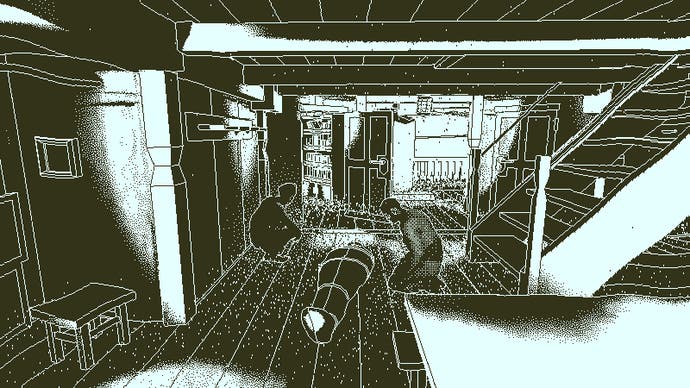
All of this feeds into the challenge of working out who they are. What clues do you have? The dialogue you've heard, for starters: did anyone use any names? Can you link those names to the people in the diorama? But wait, can you infer anything from the uniforms these people are wearing, from the accents they spoke in? Can you cross-reference what you've seen against a crew list in the book that gives names and nationalities? Can you match that to several pictures of life aboard the Obra Dinn that are included? Can you maybe take into account the location of the death, reviewing the maps of the ship's various decks, with helpful notes as to who worked where? Can you freestyle it just a little, assuming that people who are sat together in pictures may have had similar jobs? Actually, does the glossary listing the meanings of the various jobs provide any help?
Long story short, halfway through Obra Dinn I realised that what I was essentially playing was nautical murder Sudoku. In Sudoku - and stop me if you know this one - you must take a 9x9 grid and fill each 3x3 square of it with the numbers 1-9, each occurring only once. These numbers must also occur only once in each row and column of the wider grid. Luckily, there are a few numbers in place at the start to guide you. Amazingly, this is a recipe for genuine fun.
So how do you proceed? In Sudoku, you slice and dice. You deduct that a 4, say, in this row and that column must mean that the only remaining place for a 4 in this section is here. And so it is with Obra Dinn, but you're using accents, jobs, uniforms, and anything else that can be deployed. This man spoke with an American accent - how many Americans are there on the ship? This man claims to have a brother on board - how many brothers can I spot?
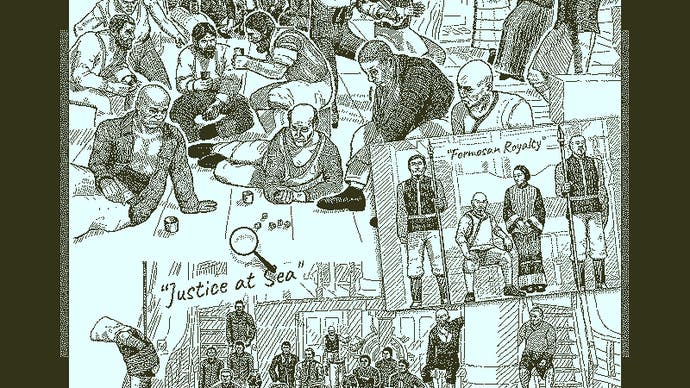
Once you've decided who died and what killed them - and the last part is often as tricky to divine as the first - you write them in the book where your answer appears in loose handwriting. Once you have three correct entries, the magical book magically confirms your deductions and the handwriting is replaced by the cold typewriter font of fact. Always these confirmations come in threes, so you can't just spam different names and different reasons for dying, I suspect, and there is a real thrill of satisfaction when you realise - yes! - you're slowly making headway. Over time, these individual deaths, presented in what initially seems like no real kind of order, slowly start to hint at a wider narrative. Keep stirring! There are wheels within wheels here, and ultimately, you can stitch all these scattered deaths together into a wider tragedy of great weirdness and richness, spotting people in early scenes who you've already seen killed in later scenes and realising that there was more to that death than initially seemed possible.
At the same time as the narrative unfolds - and speaking of unfolding, after my first playthrough, I was nowhere near the number of solved deaths needed to unlock the final twist and even now it eludes me - an oddly sensitive portrait of life onboard a merchant ship evolves. Despite the limited palette - perhaps because of it, eh readers? - the Obra Dinn is one of the most fully realised locations I've ever encountered in a game. It has carpenters, animals for slaughter, barrels and crates of mysterious stuff, a whole deck full of cannons.
It is a joy to poke around as the game slowly opens up new spaces. It is a pleasure - and a very harmonious pleasure - to come to an understanding of how different parts of the ship slot together, where people sleep, where they work, where they gather for a game of cards. That powdery white line that draws this bleak world is surprisingly adept at giving a sense of the material reality of the ship - razor sharp on the rarely-used stairs you use to climb aboard, breaking into radar-like speckles when ghosting an outline of waves into life. As your clues mount up and the images in the book become less and less fuzzy, so the world comes into focus. You are not just exploring a place, you are slowly getting a sense for it. What an astonishing game. What an incredible piece of work.
